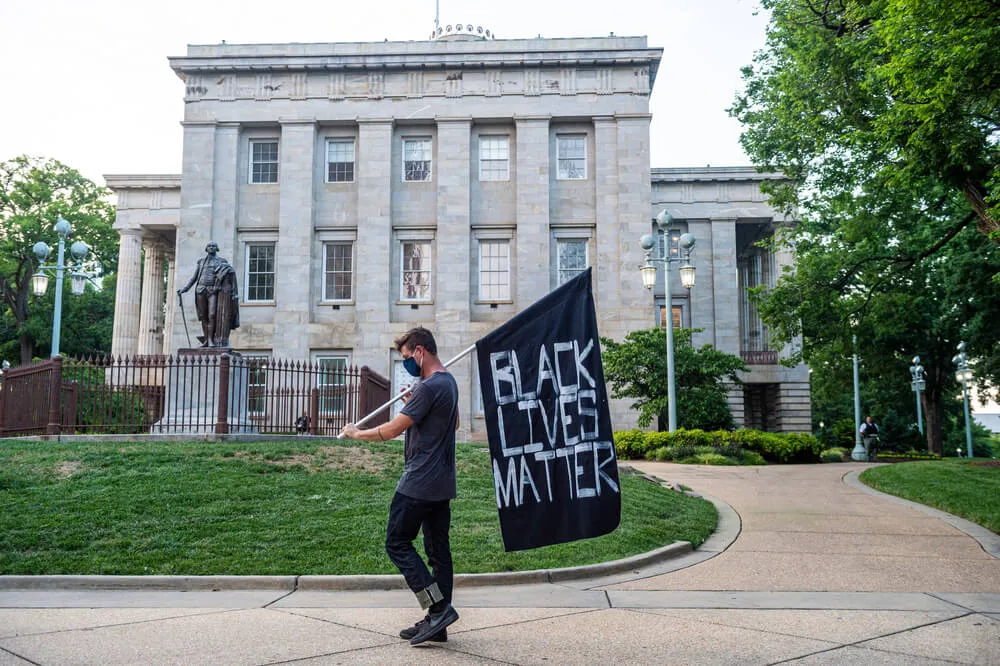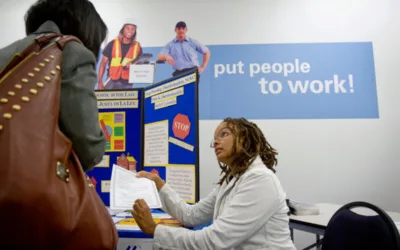
A demonstrator marches in front of the State Capitol in Raleigh in June. The Capitol has been the scene of multiple protests of racial inequality in 2020. (Image via Shutterstock)
The NC Department of Education is trying to make social studies standards more representative of our country. Getting it right is proving to be a challenge.
“George Floyd. We begin this meeting saying his name, for anything less further supports the uncomfortable silence which surrounds and upholds the systemic practices which continue to plague our nation and state, resulting in the physical and mental deaths that many Black and brown citizens experience every day.”
That’s how State Board of Education Chairman Eric Davis began the June 3 meeting of teachers from around the state. They had come together to develop new K-12 social studies standards that would determine how North Carolina’s 1.5 million public school students would be taught.
Floyd’s death has ignited conversations on racism and how it’s learned, as well the need for a deeper understanding of how society often dismisses or discriminates against people of color. Davis’s words were, in essence, an admission that the Department of Public Instruction (DPI) and academia in general were not immune from the reckoning that was taking place around the country.
There is little debate that history is taught from the perspective of those who write it, primarily whites with European ancestry and outlooks. But detangling a distorted history is complicated work.
On that day, the Board delayed the vote on the new standards until July. At the July 9 meeting, they delayed the vote again.
The standards required still more revisions to ensure that narratives of women and people from a wider range of racial, ethnic, religious, and cultural backgrounds were woven into the central narrative, and not relegated to sidebars and special sections, as is often the case. The classroom adoption was also delayed until early spring 2021 to give teachers more time to implement the new guidelines.

“The books we give to our young people are not as much of a history of us as it is a history of the wealthy and powerful and prominent.”
– NC author and historian Tim Tyson
The History of our History Books
The well-known axiom — “history is written by the winners” — doesn’t hold true for many schools in the South. Textbooks are replete with seemingly benign examples of disinformation written by Confederate revisionists. For example, some Southern history textbooks referred to the Civil War as “the War of Northern Aggression” while simultaneously boasting of Confederates firing the first shot on the US garrison at Fort Sumter.
Many others (including mine) called it the war between the states, a term that persists to this day to redefine secession as something other than treason. A Civil War means the combatants are part of one country; whereas, “war between the states” implies a war between two separate, sovereign governments.
In his book, Wilmington’s Lie, Pulitzer Prize-winning author David Zucchino details the state’s propaganda campaign to rewrite the violent events that dismantled the advances Black people made after the Civil War and during Reconstruction that led to the 1898 Wilmington Massacre.
During the massacre, white supremacists conspired to remove Black and white political leaders from the city, burning Black businesses and killing somewhere between 60 and 300. Some historians consider it a turning point in the Reconstruction-era South, instituting a period of harsh anti-Black regulation and sentiment. Yet the Wilmington Massacre remains a relatively obscure or misunderstood event, even in NC.
“Written by white supremacy inspectors in the Jim Crow era, they said there was Negro rule and that African Americans were rioting,” explains Zucchino. “So, they claimed the coup was necessary to overthrow a corrupt Black-run government and their white allies who were oppressing the true, good and decent white people.”
Zucchino says calling what happened in Wilmington, and also in Tulsa, “race riots” was a way to cast blame on the Black Americans who were violently oppressed for obtaining and attempting to use the rights they had gained under the 13th and 14th Amendments.
While there have been significant changes since the civil rights movement, author and history professor Timothy B. Tyson — whose 2004 memoir “Blood Done Sign My Name” told the story of racial tumult following the 1970 murder of a Black man in Oxford, NC — said even our current social studies textbooks are both misguided and insufficiently inclusive.
“The books we give to our young people are not as much of a history of us as it is a history of the wealthy and powerful and prominent,” said Tyson. “They focus more on white people and official people. But that’s not really the history of a people, which is more complicated and interesting. Some of the best stories are not about bills passed, programs launched, and roads built. The best stories are about what happens among people and the things that actually change our lives.
“We cling to a sugar-coated vision of North Carolina as a place where generosity, Black moderation and reasonableness came together with a kind of civility that worked toward a gradual but almost inevitable progress,” Tyson added. “It’s as if our history was just one shining arc of progress that came from a large consensus. That leaves out the parts that have made us who we are.”

What’s the plan to fix this?
The state periodically reviews and revises the standards used in different subjects. Last year, the state legislature changed graduation requirements to include a course in financial literacy. As a result, two US history courses had to be folded into one, requiring new standards.
The way history is taught in the classroom is determined by the standards states and districts give to their teachers.
Anti-racism protests and calls for equity provided a ripe opportunity to make sure the guidelines align with increasingly diverse schools and the country as a whole.
But developing new standards can be a year-long process, where draft proposals go through seemingly endless rounds of revisions. The first draft was released in December. A second draft released in April removed civics objectives to “determine the effects of institutional discrimination on cultural and national identity” and added one to have 3rd-grade students learn why monuments, including Confederate monuments, “are valued by a community.” The latter provision was removed when some educators suggested it was an attempt to make education conform to a particular worldview.
DPI is also considering an introductory statement that requires teachers to “include diverse histories, experiences and perspectives of racial, ethnic, gender, and identity minorities.”
Tina Heafner, president of the National Council for the Social Studies and a professor at UNC Charlotte, said there’s a reason many Black students feel alienated from the nation’s history.
“Black history is typically taught in schools through the prism of victimization and oppression instead of persistence and resistance,” Heafner told Good Morning America on June 30. “The curriculum is presented from that of the dominant white culture and it’s not inclusive of people of color.”
At the July meeting, Matt Scialdone, 2015 Wake County Teacher of the Year, brought several of his students from Middle Creek High School in Apex to talk about the importance of teaching the “hard history” of the targeted mistreatment of Black North Carolinians, such as lynchings and forced eugenics sterilization.
KaLa Keaton, a rising senior, said she only recently learned about the 1898 Wilmington Massacre, Tribune News Service reported. “Students of color deserve to see the accomplishments, contributions, and struggles of our communities accurately reflected in the classes we sit in every year,” Keaton said.
Professional development for teachers is key to making the curriculum work. North Carolina schools are majority students of color, but 80% of the teachers are white.
Many of them have never taken a Black history course and/or have no interest learning about diverse cultures. Therefore, if and when those standards are approved, it won’t matter if teachers fail to comply with them.
One of the few Black students at Charlotte Christian, a private school in Mecklenburg County, tweeted about her experience at @blackatcharlottechristian.
This depiction of the Civil War goes beyond mischaracterization; it is an outright lie.
Secessionists openly touted slavery and the continuation of white supremacy as central reasons for cutting ties with a federal government that was dominated by what they called “the Black Republicans.”
This rank revisionism so often comes from the adults — parents, administrators, and teachers — who learned a different version of history. For more than a hundred years, Southern students were taught that slavery was not central to the Civil War, the goal of the Confederacy was one of honor, and that the white Southerner was simply a tragic victim in the valiant fight for a noble cause.
In addition to sponsoring hundreds of Confederate monuments throughout the South, the United Daughters of the Confederacy (UDC) sought to maintain white supremacy by supplying books, papers, and pamphlets for school curriculums so, as the group wrote, “the whole civilized world will come to know that our cause was just and right.”
Do we still need history books?
During a recent webinar on textbook standards organized by Social Studies Network, a Facebook group for educators, former Guilford County Public Schools history teacher Tinisha Shaw acknowledged the elephant in the room: Education is political.
“Especially in my state, my general assembly—our legislative body—is involved deeply in how our standards are written,” said Shaw in a June 30 EdSurge report. “So these are politicians, not teachers. And, therefore, my curriculum is political. And so, I would guarantee, is yours.”
But do we even still need history books? Although Shaw has been involved in writing standards, she says she rarely used them in her own classroom because of how they are written and adapted. She believes teachers should use materials they’ve vetted for accuracy and relevancy.
This concept is gaining currency with educators who want their students to explore a greater variety of viewpoints.
“The 1619 Project,” the New York Times Pulitzer Prize-winning historical project which re-examines slavery and the Black experience, has been adapted into lesson plans in every state in the country. Some districts, including Chicago, Washington, and Newark, have formally adopted the curriculum.
This broad acceptance has caused a backlash from conservatives. Despite hundreds of years of slavery, followed by hundreds more of legalized discrimination, they deny the existence of systemic racism. Sen. Tom Cotton (R-Ark), who recently said slavery was a “necessary evil,” introduced legislation to prevent “The 1619 Project” from being taught in public schools.
“Trump, Pompeo and Tom Cotton are feeling the need to try to discredit a project that’s a year old,” said principal author Nikole Hannah-Jones during a July 22 Education Writers Association presentation. “So I think that really speaks to the power of journalism, to not just report on what’s happening, but to actually move the narrative that we’ve all long accepted.”
This is why a more inclusive history, taught with or without textbooks, is so vital.
[Editor’s Note: A previous version of this story did not properly attribute quotes from UNC Charlotte professor Tina Heafner, Guilford County Schools teacher Tinisha Shaw, and Middle Creek High student KaLa Keaton.]

Op-Ed: Studying the Holocaust remains vital to ensuring it never happens again
International Holocaust Day will be observed on January 27, 2024. This day commemorates the liberation of the Auschwitz concentration camp by the...

VIDEO: How Rural Broadband Is Coming to This North Carolina County
More than 1.1 million North Carolinians lack access to high-speed internet, a necessity of the modern economy. In Warren County, help is on the way,...

VIDEO: Sampson County puts Biden’s promise to boost rural infrastructure to the test
Locals in this rural NC county say their water and air is polluted by a PFAS-contaminated landfill, massive hog and poultry farms, and industrial...

VIDEO: Sampson County puts Biden’s promise to boost rural infrastructure to the test
Locals in this rural NC county say their water and air is polluted by a PFAS-contaminated landfill, massive hog and poultry farms, and industrial...

Mold and classes in trailers: Inadequate funding for schools is hurting NC communities
Schools across the state are dealing with dilapidated classrooms and buildings in need of significant repair or a total rebuild due to a lack of...




